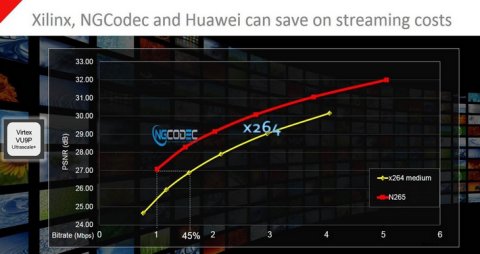Xilinx and Huawei Announce the First FPGA Cloud-based Real-time Video Streaming Solution in China
Available soon in the Huawei Cloud, H.265 Standard from NGCodec Powered by Xilinx FPGAs
SHANGHAI -- Oct. 15, 2018 – Xilinx, Inc. (NASDAQ: XLNX), Huawei, and NGCodec, today announced the development of China’s first cloud-based high-efficiency video coding (HEVC) solution, which is uniquely enabled by Xilinx® Virtex UltraScale+™ FPGAs and NGCodec’s H.265 video encoder. This technology will be offered in the HUAWEI CLOUD FACS (FPGA Acceleration Cloud Server) and will be available before the end of the year. This will enable the first broadcast quality real-time streaming solution using FPGA’s in a scalable cloud infrastructure in China.
“The unique combination of Xilinx’s powerful and adaptable FPGA technology with NGCodec’s HEVC encoder are enabling a set of solutions that were previously not possible,” says Sean Gardner, senior marketing manager, Cloud Video, Xilinx. “Huawei is leading the industry by being the first to implement FPGAs for high-definition, real time video streaming in its cloud infrastructure and bring it to China – the world’s largest market for live video streaming.”
Video streaming is a critical workload for China and companies are struggling to roll out infrastructure at the necessary pace to meet rapid growth combined with peak demand. Traditionally, companies have looked towards GPUs as a viable option, but the Xilinx FPGAs running on the HEVC codec offers 35-45 percent lower bitrate at the same visual quality. This reduction delivers a massive improvement in bandwidth and storage costs.
“To grow our share of this exciting, exploding market, service providers must deliver the best end-user experiences. Other technologies were not able to meet our specifications,” says Anders Zhaogang, Huawei FPGA Acceleration Cloud Service technical leader, Cloud BU-Computing Service Domain Program. “Our high-performance streaming solution now makes it possible.”
The HUAWEI CLOUD HEVC solution enables 1080p picture quality at 60 frames per-second, with a roadmap to 120 frames per-second. It offers fast integration into existing video workflows to accelerate core video functions. And like all Xilinx technology, users can update codecs to achieve higher performance. Moreover, Xilinx has implemented its technology using the open-source FFmpeg media framework opening the door for any user to reap the benefits that FPGAs offer.
The HUAWEI CLOUD HEVC solution will be demonstrated today at Huawei Connect, taking place 10-12 October 2018 at the Shanghai World Expo Exhibition and Convention Center, Shanghai, China.

About Xilinx
Xilinx develops highly flexible and adaptive processing platforms that enable rapid innovation across a variety of technologies – from the endpoint to the edge to the cloud. Xilinx is the inventor of the FPGA, hardware programmable SoCs and the ACAP, designed to deliver the most dynamic processor technology in the industry and enable the adaptable, intelligent and connected world of the future. For more information, visit www.xilinx.com.
Related Semiconductor IP
- H.265 Decoder
- H.265 Encoder
- H.265 - Efficient video compression for high-quality, low-bandwidth streaming
- H.265 Codec - Efficiently compresses high-quality video for streaming and storage
- H265 ENCODER IIP
Related News
- Xilinx Announces Real-Time Server Appliances for High-Quality, Low-Cost Live Video Streaming
- Pinnacle Imaging Systems and ON Semiconductor Collaborate on New HDR Surveillance Solution Using Xilinx Technology to Push the Boundaries of High Dynamic Range Video
- Allegro DVT Introduces the Industry First Real-Time AV1 Video Encoder Hardware IP for 4K/UHD Video Encoding Applications
- China, Huawei Hit Q'Comm Where it Hurts
Latest News
- TSMC to Lead Rivals at 2-nm Node, Analysts Say
- Energy-efficient RF power modules developed using SOI technology
- Quintauris Demonstrates RISC-V Innovation in Automotive at CES
- UMC Reports Sales for December 2025
- Tenstorrent unveiled its first-generation compact AI accelerator device designed in partnership with Razer™ today at CES 2026